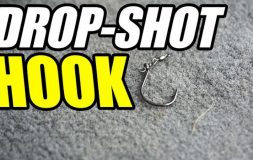How to catch more bass in late winter with the T-boned spaz crankbait
When it comes to bass fishing, there are literally thousands of baits to choose from. What REALLY matters are your rigging and retrieval techniques, and how good you are at deciding which tackle combo to use in various fishing conditions.
In Travis Moran’s latest video, he breaks down a brand new lure from Bait Rigs, the T-Boned Spaz Crankbait! The T-Boned Spaz looks like a traditional jerkbait, but it has some cool new features that make it an ideal lure to use in cold-weather, windy fishing conditions:
- The full cup lip creates an erratic motion underwater that gets the attention of bass.
- Side rivets displace water and alter the sound vibrations that bass are listening for.
- A weight transfer system allows you to get the right leverage to cast the lure far out.
- This bait comes in 13 different colors so you can be prepared for all water situations. If you’re interested in purchasing these lures individually, you can visit Bait Rig.
Of course, no angler education video is complete without rigging and retrieval recommendations. To catch more bass with the T-Boned Spaz Crankbait, Travis uses a 7’6” medium heavy moderate action rod, a medium gear ratio reel, and a 12- or 15-pound mono or fluorocarbon line.
When it comes to retrieval, Travis likes to throw the T-Boned Spaz like any other traditional jerkbait. First, he makes as long of a cast as he possibly can, past his target spot. Then, on a semi-slack line, he reels down two or three times until the bait is to an optimal depth, about 4 or 5 feet. Then, he starts jerking the bait. Travis likes to jerk, jerk, jerk, and then pause, which gives the bass time to bite.
Here are a few more tips and tricks from Travis. Let us know your favorite in the comments below!
1) Choose A Color According To The Water
During early morning and late evening, or in any low light condition, fish can’t see very well. That’s when Travis chooses a lure with a solid color that has a flat finish. When the sun comes up, or if he’s fishing in super clear water, Travis likes to throw a more transparent, natural-looking color. If he’s fishing in dingy, murky water, Travis chooses a more vibrant, light-reflecting color, such as chartreuse. Remember – the #1 goal is to not spook the fish, so you should always be sure your lure looks as real as possible.
2) Bait Fish Location Is Always Key
Many baits are designed to mimic bait fish, so you need to fish in the areas where bait fish love to hang out. Remember – where the bait fish go, the bass will follow. The most common areas for bait fish to be are across main lake points, across some good secondary points, or in the back of some creek channels. When Travis locates a good fishing spot, he likes to cast across it, and then retrieve slowly. As the bait moves towards the boat or bank, its erratic motion will catch the attention of the bass waiting below.
3) Wind Can Be A Fisherman’s Friend
Although many anglers would prefer to fish on a calm body of water, Travis actually likes to fish when it’s a little bit windy out. According to Travis, a strong breeze disturbs the water and disorients light penetration, which makes bass feel comfortable coming up shallow to feed. Additionally, wind blows the plankton and microorganisms that bait fish feed on up against the bank. And – again – where the bait fish go, the bass will follow. So, if you’re fishing in a windblown bank, there’s a good chance you’ll get a bite… or 2, or 3, or 4.
That’s it for now, anglers. We hope you enjoy these fishing tips from Travis Moran!
Tight lines until then!
How To Catch More Bass In Late Winter With The T-Boned Spaz Crankbait – VIDEO TRANSCRIPTION
Hey guys, Travis here with a brand new lure from Bait Rigs called the T-Boned Spaz. Its body type is just like a traditional jerkbait, with some really cool features they’ve added in, starting with the lip on this. We’re used to seeing more of that rectangular lip, but now they have put a full cup in the front, which is going to create even more erratic motion, which is what you’re looking for to generate strikes, and it’s also going to make that bait easier to get that different walking erratic motion out of this bait.
00:30
The next, if you look down the side of the bait, you’ve got these little rivets. This is going to displace more water, changing the sound vibrations that these fish are picking up on, and generating more strikes. Then you’ve got a weight transfer system within the lure, so you’ve got a little ball that knocks around while you’re working it, but when you go to cast it, that little weight goes to the tail end of this bait, and that’s the right leverage for when you cast this bait, it’s going to cast a long distance. Lastly, this bait comes in a wide variety of baits (colors), so whatever flavor you like, or the bass like, you’re going to be able to present that to them.
1:06
So anyway, now let’s talk about how to fish this bait, starting with rigging. So, first off is the rod that I’m throwing this on. I have a seven foot six, medium heavy moderate action rod. I want a lot of taper in that rod, but enough backbone to be able to make long casts, and be able to work this bait with the little jerks on it. But then I need enough tip, I need to have enough bend in that rod so that the rod can basically spring back and forth as I’m working that bait, and that’ll allow that bait enough give, so it can really work back and forth and create that erratic motion you’re looking for to generate strikes. Then lastly, when the fish actually do bite, you want that rod to give. When those fish make those runs and everything, you want give before that line engages, that drag engages, so that the fish doesn’t come free. I’ve got a medium speed gear ratio here on a reel, and then lastly, I’m going to spool up with either 12 to 15 pound mono or fluorocarbon.
2:04
All right guys, when selecting colors for the day, when I start off in the morning, those low light conditions, or later in the evening, how those fish cannot see very well, there’s not much light reflecting, I’m going to go with more of a solid color. This is more of a flat finish, so these fish can really see it. It doesn’t need to reflect the water, it can actually just be seen and heard very well in that low light condition. Once the sun comes up, if I’m fishing super clear water and it’s semi calm conditions, just a little gentle breeze, I’m going to throw a little bit more transparent color like this. A real natural looking bait, because these fish can really see it from a long ways away, and so I don’t want them to get spooked, I want it to look very real to them.
2:48
Now, if I’m fishing dingier water, I’m going to throw something a lot more vibrant. I’ve got this chartreuse color, so it can really show up in that water, that sound’s going to play a big role, and then them being able to see it is a big deal. Also, if it’s real windy, or if you’ve got a lot of disturbance in the water, a little bit of murkiness to it, I want a lot of flash. So, I’m going to throw something with a lot of shimmy to it, a lot of shine. This really catches the sun’s light, and it’s going to reflect, and it’s going to help those fish hone in, see it, and come in and strike it.
3:24
All right, so in terms of retrieval, I really throw this like I would throw any traditional jerkbait. However, if you’re new to throwing a jerkbait, or a rib bait, there is a certain way you do it to make sure you get that erratic motion, which is what you’re aiming for to generate these strikes. So, what you’re going to do is you’re going to make as long a cast as you possibly can, so that’s why having the right gear, which we just discussed is very important, so you can really perform well on your casts. Then, on semi-slack line, now you want to cast it past your target, which we’re going to talk about also here in just a second, in location. But you cast past the target, and the first thing you do is reel down two or three times, two or three turns of that reel to get the bait down to your optimum depth, which would be about four or five feet. This bait really runs about four to seven feet, depending on the size of line, and how far you cast it.
4:16
Then next, on semi-slack line, so you want pretty tight line, you’re going to start jerking that bait. That’s why the baits are called jerkbaits, that’s why this family of style baits is called jerkbaits, is because you’re jerking that bait. Now, you want to jerk it on semi-slack line. The best way I can describe it is you’re really snapping the rod. You’re snapping, so it’s got slack line, and you’re snapping, snapping. And the reason being is, if you have a little bit of freedom in that line, when you snap it, that bait will pull forward, but then if you had just tight line, it would pull forward, forward, forward.
4:53
But instead you have slack line, so it pulls forward and then has the freedom to dart, and that is what generates these strikes. That’s what draws the fish in, and that’s what going to get these fish actually biting this bait, is that erratic motion you’re getting out of it. And that’s where this lip always plays a big key, is because it’s going to now dart side to side, diagonal, down, up, all over the place, really looking like a wounded, confused bait fish, and those bass will not be able to resist it.
5:23
Now, there are some little nuances you throw in throughout the day to match the situations you’re fishing. So, once you get that cadence down, jerk, jerk, jerk and that bait is darting all over the place, you’re doing a nice semi-slack line, you’ll be able to see it. I recommend practicing a couple of times close to the boat, so you can really see what kind of motion you’re trying to get out of that bait. Then, add in some different little variables. A lot of times I’ll do a jerk, jerk, pause. Jerk, jerk, jerk, pause. And the pause can be a second to three seconds. Generally, you can even go longer if you want, but I like to do that one to three second range, and that’s a lot of times going to be where those fish are actually going to hit the bait. That erratic motion gets their attention, and that pause gives them the opportunity to strike.
6:11
Another little trick I’ll do is I’ll jerk, jerk, jerk, and instead of pausing, on that pause I’ll just slowly reel in the slack, and what that’s going to get the bait to do is to still slowly be tracking. So, you’re seeing that bait dart, dart, dart, and then slowly track. Dart, dart, track. And sometimes that’s what’s needed to get the fish going as well. But the reality is, you’ve got to mix it up throughout the day and figure out what the fish are responding to. If they’re not heavy feeding, they don’t want just a straight jerk, play with that pause. Sometimes they need that pause to come up from deeper water, or they’re just sluggish fish, but the jerkbait will still work. You’ve just got to give them enough time to come get it.
6:54
Anyway guys, just as important of how you’re retrieving is where you’re throwing it. So, let’s talk about some of my favorite areas to throw this little Spaz in location.
7:05
Hi guys, this bait is made to mimic bait fish, so you’ve got to fish in the areas where bass are waiting to ambush bait. The most common areas are across main lake points, across some good secondary points, or in the back of some creek channels where bass are schooling up bait and really chasing them deep down in that gut of that creek channel. Also, any kind of seawall or banks, where there’s a little breeze pushing up, are also excellent targets, and we’ll talk about why in just a second. But first, the way to fish these locations is I like casting across, which we talked about in retrieval. The idea is that these fish are sitting deeper down below these points, and as that bait comes across there, that erratic motion comes across that shallow part and then comes back into deep, those fish will be ready to ambush it. They’re waiting, they see that bait coming across, and they will smash it.
8:00
Now, some other elements that I look for for good jerkbait fishing are low light conditions, early morning, late evening, but most importantly, my favorite, favorite time to throw a jerkbait style bait like this is when the wind is blowing. It can be frustrating, we like that calm conditions, especially when we’re starting off fishing, so we can really work baits thoroughly, so we can work that jig, or that worm down there. But the reality is, when you get a little breeze going, it disturbs the water, it messes up the light penetration and disorients things down there, and the bass use that to their advantage, and they come up shallow and feel comfortable coming up shallow to feed, which is exactly what you need when using this bait.
8:44
The other thing that happens when there’s wind blowing, is it blows those little plankton, or microorganisms and things that those little bait fish feed on, it blows them up against the bank. So, whether it’s a seawall or there’s just some random bank on the lake, if you’ve got the wind blowing against it, you’ve got a lot of food for these little bait fish, and the bass know this as well because they want to eat those bait fish, and those bait fish are feeding upwards, so the bass are going to be feeding upwards. So, if you go to a windblown bank, or a point that’s got the wind blowing across it, you fire up shallow, and you bring that bait into deeper water, those fish are going to be sitting just below, whatever the little drop off there is, they’re going to be sitting right there waiting for some unsuspecting bait fish to come out like this, and they are going to pound it. Hope that helps guys.
9:30
Anyway, Bait Rigs, brand new T-Boned Spaz. I want to hear your thoughts on it. What color do you like? Have you caught any fish on it? Leave a comment below. Anyway guys, I’m Travis Moran with Lucky Tackle Box, and I will catch you out on the water.
###
Check out this monthly fishing box and get all the best fishing gear. Yes, we can deliver it.










